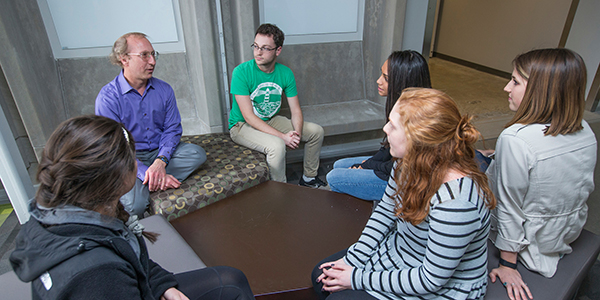
Small Groups Large Learning
Story by Ed Adcock
Image by Christopher Gannon
Clark Coffman says it can feel daunting facing hundreds of students in a lecture hall as part of the large introductory science classes he teaches.
“If you’re outnumbered 400 to 1, how do you get students to learn?,” asks Coffman, an associate professor in the Department of Genetics, Development and Cell Biology. The answer? Engagement.
“If you get the students engaged, they’re going to learn more. Our goal is to get them to take something and grapple with it,” he says.
Coffman won the College of Agriculture and Life Sciences outstanding teaching award in 2017 for his innovative approaches. He is part of a team in his department teaching Principles of Biology II, a lecture and lab course exploring cell biology, molecular biology and genetics. He also is part of a team of Iowa State faculty awarded a National Science Foundation grant to research ways to improve student achievement in large science classes.
Besides the sheer number, his students range from freshman to upper classmen, encompassing 60 to 80 majors, with varied backgrounds and abilities.
The teaching team has adapted a model developed at the University of Colorado to employ undergraduates who have taken the course or a similar one as learning assistants. The assistants move around the room and work with groups of four to seven students engaging in course exercises. Comments from student evaluations reflect the value of the learning assistants, or “LAs”:
• “What I LOVED about this class was that there were teaching assistants or LAs that were extremely helpful. They were always there to explain some- thing we did not understand.”
• “A lot of students, including myself, do not like to ask a question that over 300 other students will hear. So I was much more comfortable asking a LA for help.”
The learning assistants are part of the instructional team and meet with the instructors weekly to plan the coursework and strategize techniques for achieving course outcomes. Coffman often asks them: “What made it click for you when you were trying to learn a particular concept?”
Since the new model began, the number of students getting a D, F or dropping the course has decreased.
“Students are staying enrolled and their performance has improved,” he says. “A lot of these students are in their rst set of science courses and we’re not doing them any favors if we drive them off.”
Students often feel if they have to work at learning something, they are doing something wrong. Research shows we learn through engagement and making mistakes, he says, so the teachers use information from class research to show students if they put in the effort they can learn and be successful.
“We want to teach them it’s okay to make mistakes, to get them out of the pressure of the exam-taking mode and into learning mode,” Coffman says.



